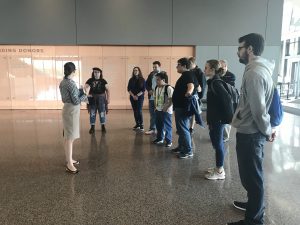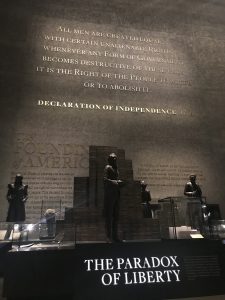by Keely Bluett, Public History Major, ’22
On April 12th, York College’s spring 2019 Introduction to Public History class took a field trip to the National Museum of African American History & Culture (NMAAHC) in Washington, D.C. This course, taught by Dr. Jacqueline Beatty, details the paramount role of a public historian in the multitude of educational, professional, and influential outlets. Our trip to NMAAHC provided students with the chance to analyze and experience our course material in real time, while also receiving direct insight into the field with a private tour from one of the museum’s Curatorial Assistants, Dr. Lindsey Bestebreurtje.

Dr. Bestebreurtje detailed her expertise of researching historical material and artifacts for the museum, analyzing its application to the overall narrative, and gaining possession of the material for NMAAHC to use. Deciding what information will be presented to society is the foundation of public history. A historical and accurate narrative must stay consistent throughout a site, ensuring that the public will leave with the intended experience and gained concepts of history.
The National Museum of African American History & Culture is a prime example of presenting difficult history, a concept discussed throughout our Public History course. For NMAAHC, the goal was to display African-American history through an accurate narrative and logical framework, insuring to supplement any collective disinformation among the public. Ultimately, the museum is meant to evoke representation of a stifled narrative throughout American history. For students, exposure to difficult history and the methods of its presentation is crucial in the field of history.
The museum starts with an elevator ride moving downwards, with a visual timeline backtracking to the 15th century, at the start of the Trans-Atlantic Slave Trade. This feature allows visitors to feel a physical transport into the selected period. The museum presents European and African history as parallels along a winding hallway, guiding visitors through the physical space and the creation of the United States of America. Each element of the museum is meant to develop a deeper understanding of slavery and African-American history for the visitor. It teaches not just facts and figures, but the personal stories of hundreds of thousands subjected to violence, racism, and the deprivation of basic human freedoms. Material objects such as slave shackles, Nat Turner’s Bible, and Harriet Tubman’s shawl encourage a deeper understanding for the visitor.

On the first floor, a rare narrative of Thomas Jefferson is displayed, detailing his role of slave master in juxtaposition to his ideology of American freedoms and liberties. This is an example of altering the public’s skewed collective vision to a more accurate, well-rounded narrative, serving an important lesson in public history.
As visitors move through the space, ramps take them upwards to the next exhibit, symbolizing the continual progression of African-American history. Multiple mediums of communication engage the audience, such as photographs, artifacts, text, and videos. Touch-screen interactive tools are also available at a lunch counter, simulating the Greensboro sit-ins of 1960. Other simulation experiences include a slave cabin and segregated train car. Multiple methods of learning are available to the public. The continuous emotional outreach of NMAAHC brings visitors to the optional, secluded area where Emmett Till’s casket is displayed. The seclusion is a deliberate choice from the museum’s curators and designers, as the experience presented is extremely sensitive and heartbreaking.
Through the lenses of public history and the perspective of a visitor, NMAAHC is an important addition to the National Mall. Its immersive experience pays close attention to detail and historical representation, evoking audiences to become immersed in its message. The opportunity to visit and pinpoint the principles of public history throughout the site was a valuable experience for the class.
